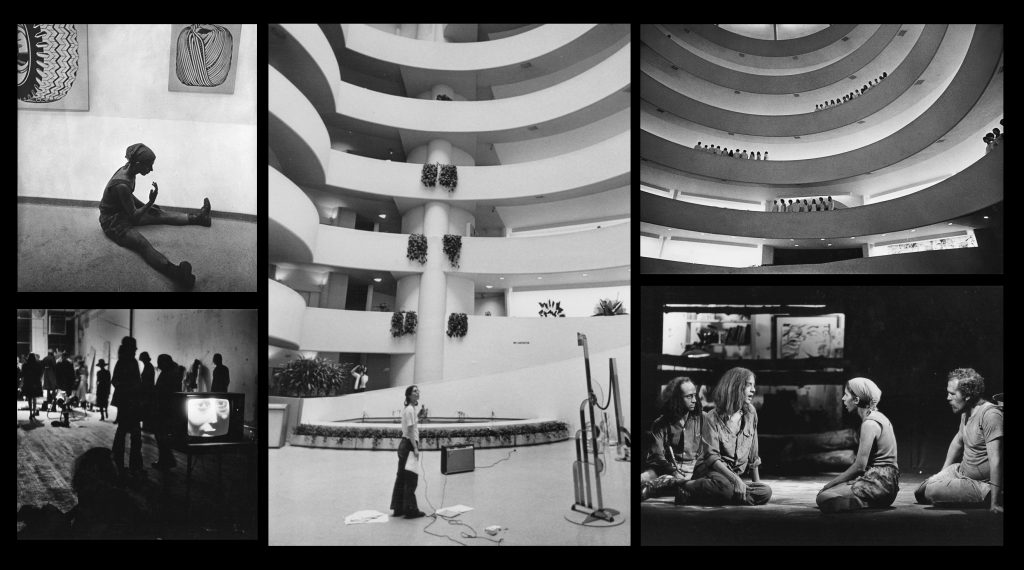
(top left, right and middle) V. Sladon (bottom left and right) Peter Moore
Juice: A Theatre Cantata in Three Installments (1969)
Pioneer of site-specific works, Meredith Monk began working in unconventional spaces in the summer of 1967 with her work, Blueprint, which she extended into a three-part durational piece performed in New York in December 1967. After forming her interdisciplinary company, The House, in 1968, Monk began to expand this concept to include large groups of local performers in works performed in various architectural spaces such as the Museum of Natural History at the Smithsonian Institution in Washington, DC, the Chicago Museum of Contemporary Art, and a factory in Buffalo, NY. Taking place the following year, Juice: a theatre cantata in three installments became one of her most important site-specific works. “A dialogue about how space affects images and time,” Juice was performed in three installments, each at a different venue over the course of a month. In each installment, Monk reconfigured the relationship of the audience to the performers. The metaphor Monk often uses in describing the experience is that of a zoom lens, as the viewer’s perception shifted from the monumental to the intimate.
The first installment of Juice took place at the Solomon R. Guggenheim Museum in New York on November 7th, 1969 and was the first time a work of live art occupied the museum’s rotunda since its opening ten years earlier. Elements of the piece included a woman on horseback; 75 singer-dancers in white, wearing red combat boots, performing vignettes and singing plangent choral music on the museum’s spiraling ramps (where an exhibition on Roy Lichtenstein was installed); and a group of four principal performers dressed in red, their red-painted bodies linked together, moving through the space as one figure.
A month later, from November 29th to December 1st, the second installment was presented at Barnard College’s Minor Latham Playhouse. Elements from the first part of the piece were revisited, though in smaller scale: a toy rocking horse was substituted for the real horse; a Lichtenstein poster hanging inside a log cabin stood in for the museum exhibition; and the four characters that had been connected in Part I became separate figures.
The third installment of Juice took place a week later on December 7th at Monk’s loft in lower Manhattan. Here, audience members walked through an array of objects and costumes used in the previous two parts. The four characters that had been the focus of Parts I and II were now only visible on videotape.
Music, movement, direction: Meredith Monk
Performed by The House: Dick Higgins, Susan Larrison, Madelyn Lloyd, Meredith Monk, Monica Moseley, David Schiller, Daniel Sverdlik, and additional cast of 75
Instrumentalists: Don Preston and Daniel Zellman
Lighting: Beverly Emmons
Sound Engineer: Daniel Zellman
Videos for Part III: David Schiller
“Even after forty-five years, Juice feels remarkable not just for its ethereal beauty but for how profoundly it reconfigured the audience-performer relationship within a specific architectural setting. Along with her unique extended vocal technique, these elements became integral to Monk’s groundbreaking practice that blends music, dance, film, and theater.”
-Nat Trotman, Guggenheim.org, 2014
“Miss Monk, who has often isolated the commonplace in movement, now stands revealed with some help from Frank Lloyd Wright, as a master of the spectacular. Her exploration of the Guggenheim’s architectural possibilities for a performing group of 85 was nothing short of brilliant.”
-Anna Kisselgoff, The New York Times, November 1969
AUDIO:
“Porch” and “Change” from Juice can be heard on Meredith Monk’s first recording, the Lovely Music release, KEY (1971). “Porch” can also be heard on the Tzadik release, Beginnings (2009), a collection of hand-selected archival recordings by Meredith Monk.
TO PURCHASE
MORE INFO on Key
MORE INFO on Beginnings
SELECT BIBLIOGRAPHY:
“Guggenheim Offers a Setting For ‘Juice’, Dance by Miss Monk” by Anna Kisselgoff; The New York Times; November 8, 1969.
“‘Juice’ is Meredith Monk at Her Avant-Garde Best” by Robb Baker; Chicago Tribune; December 3, 1969.
“Dance- Echoes and Reverberations” by Deborah Jowitt; The Village Voice; December 11, 1969.
“Meredith Monk at the Guggenheim Museum, New York City” by Jennifer Danziger; Dance News; December 1969.
“Meredith Monk: An Introduction [by Angela Westwater] and A Metaphoric Theater” by Mark Berger; Artforum; May 1973; pp. 57-63.
Meredith Monk (PAJ Books: Art + Performance); ed. Deborah Jowitt; Johns Hopkins University Press, Baltimore, 1997.
Kaye, Nick. “Space as Map and Memory: Meredith Monk” and “Meredith Monk, Site-Specific Works”. Site-Specific Art: Performance, Place and Documentation. Routledge, New York, NY. 2000.
Kloetzel, Melanie and Carolyn Pavlik. “Meredith Monk, Interview & Meredith Monk as Site Pioneer, 1969-1971”. Site Dance: Choreographers and the Lure of Alternative Space. University Press of Florida, Gainesville, FL. 2009.
Marranca, Bonnie. Conversations with Meredith Monk. PAJ Publications. New York, NY. 2014.
“The Idea of Compression: Meredith Monk’s Juice (1969)” by Nat Trotman; Guggenheim.org; October 8, 2014.